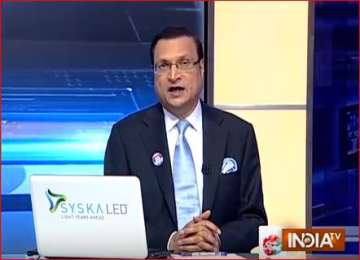Opinion | Aaj ki Baat Nov 22 episode: Rajat Sharma on how pollution in cities is causing rise in number of diabetics
If we study the problem in depth, we can observe that overpopulation in metros and other cities is one of the major causes of pollution. This is not limited to Delhi NCR alone, other big metros are facing a similar problem.

Even as the people of Delhi NCR suffer from persistent air pollution, with smog covering the national capital in the morning nowadays, a new study published in the Lancet Diabetes and Endocrionology Journal, shows that outdoor pollution is causing diabetes among people, mostly children, in India.
Till now, we knew that the causes of diabetes are hereditary, lifestyle and diet disorders, but this study has added a new dimension. The study says, Type-2 diabetes is expected to rise by more than a fifth, from 406 million in 2018 to 511 million in 2030 globally. India, along with China and the US will share over half of these high blood sugar cases, and there will be need to improve access for the life saving insulin. By 2030, the study says, China will have 130 million and India will have 98 million Type-2 diabetics.
The study says, airborne microscopic pieces of dust, smoke, liquid droplets and soot can enter the lungs and invade the bloodstream, which can contribute to stroke, kidney failure, cancer and heart disease. Among prospective diabetics, air pollution can trigger inflammation that reduces the production of insulin. The research says, air pollution contributed to 3.2 million new diabetes cases during 2016. Already, 8.2 million lost their lives due to pollution linked diabetes, says the study.
Scientists at the Washington University of Medicine, St. Louis, US, did a research for eight and a half years on war veterans, who had no family history of diabetes, and found that 2.5 PM (particulate matter) in air caused diabetes among most of them. The study showed that harmful particulate matter reached the pancreas, and disrupted the production of insulin.
For India, this news is worrying. World Health Organization (WHO) has prepared a list of most polluted cities of the world, and the names of 14 Indian cities figure in that list. I asked my reporters spread in different cities to speak to doctors and experts to find out how pollution is causing diabetes, even though people follow a regulated lifestyle on medical advice.
Our reporter Nirnay Kapoor spoke to doctors in Ahmedabad. Dr. Rucha Mehta, famous endocrinologist, who has worked and done research in the US, told him that pollution not only affects the lungs and heart, but it also disrupts hormone secretions in the body. Hormone imbalance causes several diseases, mainly diabetes. She said that most of the women patients were already either in the pre-diabetic or proper diabetic stage, due to pollution, but she added, the most worrying point was that children are now suffering from diabetes.
Our reporters in Mumbai, Chandigarh, Lucknow, Kolkata and Jaipur also met diabetics and doctors and found the same pattern. In most of the cases, cases of diabetes have been attributed to pollution. Children suffering from diabetes are taking insulin injections on a daily basis at this young age.
Two main diseases, cancer and diabetes, are spreading fast across the world. Both are silent killers and fatal. Every fifth Indian today is suffering from diabetes. A rough estimate puts the figure at nearly 25 crores.
If we study the problem in depth, we can observe that overpopulation in metros and other cities is one of the major causes of pollution. This is not limited to Delhi NCR alone, other big metros are facing a similar problem. For example, the national capital has natural resources and public infrastructure to host a population of up to 50 lakhs only, but the population in Delhi now has already crossed 2.5 crore. On an average, five persons are utilizing the resources and infrastructure available for a single individual.
The overcrowding of cities is due to lack of employment opportunities and better lifestyle options available in the villages. Millions of villagers have moved towards cities in search of job, food and basic civic facilities. Most of the rural areas lack proper schools, hospitals, job opportunities, and thus, the migration towards cities continues. The only way to stop migration to cities will be to improve the living conditions and job opportunities in rural areas. That is how we can address the root of the problems that relate to pollution and overcrowding of cities.
Watch the full episode here:
Aaj Ki Baat: Monday to Friday, 9 PM
India’s Number One and the most followed Super Prime Time News Show ‘Aaj Ki Baat – Rajat Sharma Ke Saath’ was launched just before the 2014 General Elections. Since its inception the show is redefining India’s super prime time and is numerically far ahead of its contemporaries.